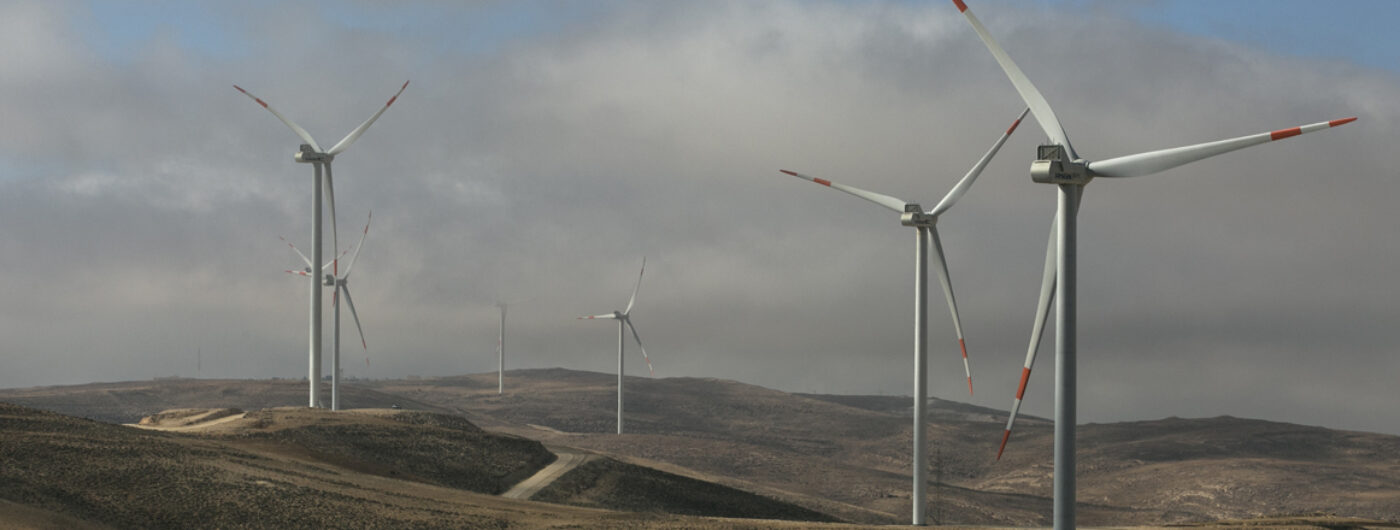
The wind of change: on the making of a renewable energy industry in Jordan
Each year, the UN Climate Change Conference of the Parties – the famous COP – takes place, and each year, the popular hopes to avoid cataclysmic climate impacts on human societies grow dimmer. International negotiations can be frustrating due to the difficulty of reaching a consensus within the deep ocean of the world’s nations, which bring to the table different interests, needs and priorities.
Grim outlooks such as this one can easily make us forget that solutions exist and are already being implemented around the globe.
And just as nature is reminding us – through climate change – of the human folly and our unsustainable ways of life, it is also within nature that the answers to our problems can be found.
The Tafila Wind Farm, owned and developed by the Jordan Wind Project Company, was at its inception a one-of-a-kind project and the first of its kind for its home country, Jordan, but also for the wider Middle Eastern region. Behind this project is an affable businessman, Samer Judeh, a visionary leader who has been instrumental in driving the wind farm’s success. With silver hair and a permanent smile, his approachable demeanour can easily make one forget that Samer was a pioneer in building the renewable energy industry in Jordan.
In 2010, Jordan was importing 97% of its energy mix. Lacking natural resources as is traditionally understood as oil, gas, metal and stones, the country heavily relied on fluctuating commodity prices that reached a peak following the 2011 so-called “Arab Spring”. Today, renewable energies make up to 20-25% of Jordan’s energy mix, while the country aims to achieve 50% by 2030.
Going slightly back in time, it is around the year 2005 that Samer started noticing rudimentary devices installed on the rooftop of hundreds of houses in countries blessed with year-long sunshine, such as Greece, Italy or Jordan itself. These solar thermal heaters were used for water heating, an astute solution that allowed families to save money on energy bills while being environmentally friendly. Awakening Samer’s curiosity, the businessman started self-educating on the potential of solar and wind energy technologies. One thing leading to another, he came across entrepreneurs, investors and developers involved in renewable energy projects and undertook several field trips that took him to all corners of the world to observe, study and compare. Thinking about his homeland, Samer knew that what Jordan lacked in underground resources could be compensated by aboveground riches: Jordan’s wind and sun.
Backed and labelled by UfM member states since 2014, Tafila now powers 83K homes and created 350+ jobs for the local community during construction
When he approached Jordan’s government, in 2007, to propose building a 10 Megawatts solar plant connected to the grid, legislation didn’t exist at the time to enable such projects. Everything was new and everything had to be built from scratch, with steep learning curves along the way. Then in 2010, he proposed to the government to build a utility-scale wind farm.
The project finally came to being in 2015, and Samer emphasizes that the project’s success was due to the collaboration between different parties, including solid and prestigious investors, the Jordanian government, international lenders and the local community.
Fast forward to the present day, the Tafila wind farm has a total capacity of 117 Megawatts, enough to power more than 83,000 homes in Jordan and reduce carbon emissions by over 235,000 tons annually. 
Recognized as one of the Middle East’s most prestigious energy projects, it became a model and a template for more than 20 subsequent renewable energy projects, generating a positive ripple effect based on knowledge transfer and lessons learned. And it didn’t stop there: in addition to providing a much-needed relief on Jordan’s energy security, Samer is also very proud of the positive impact it had on Tafila’s local community. Marked as a project priority, the businessman made sure that all the wind farm’s subcontracts were awarded to qualified local subcontractors, while all the supply chain related to either food, accommodation or local materials were procured from the area. Generating more than 350 jobs for the community during its construction phase, the wind farm’s engineers and 70 staff members today also come from Tafila and its surrounding areas, demonstrating that renewable energy projects can be both sustainable and economically viable.
Even after all these years, Samer admits with a smile that he is still in awe whenever he stands below one of the wind turbines on the field:
“When I look up, I still can’t believe we did this. It is truly a blessing being part of an initiative, as small or large as it may be, that really is not just benefitting you as a businessman or a person, but also your country, your region and, on a larger scale, the world as a whole”.
Samer Judeh, Co-founder and Chairman of the Jordan Wind Project Company
The Tafila Wind Farm is not just a story of success, but it’s a story of hope. It’s about how we can come together and build a better world, one step at a time. It’s about creating a world where our children can breathe clean air, and where nature and humanity can coexist in harmony. It’s about making a difference and inspiring change in the world.
More on the UfM actions on energy and climate change
- Learn more about the Tafila Wind Farm project
- Discover the findings of the first scientific report on the impact of climate change in the Mediterranean
- What are the UfM actions on energy and climate change? Check it out here.
- Dive into the UfM regional platform on Renewable Energy and Energy Efficiency
